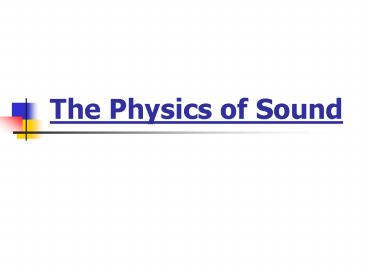The Physics of Sound PowerPoint PPT Presentation
1 / 27
Title: The Physics of Sound
1
The Physics of Sound
2
- Sound a series of disturbances of molecules
within, and propagated through, an elastic
medium or - Sound is an alteration in the pressure,
particle displacement propagated in an elastic
medium - Elasticity capacity of a medium to return to
its original position after being altered - Brownian motion heat effects particle velocity
heat velocity
3
Sound Wave
4
Sine Wave
5
Compression\ Rarefaction
6
Degrees of Wave
7
Wave Length
8
9
Velocity
- Acceleration increase in velocity
- Deceleration decrease in velocity
- Increase density increase V. (fastest in
solids, then liquids, then gases)
10
Degrees of Sine wave
11
Sound Characteristics
12
Damping
- Free vibration - when no outside force is added
to vibration - Lightly damping - when vibrations of a mass decay
over time - Heavy damping -
rapidly - Critically -
before 1 Hz. - Forced vibration - when outside force is added to
vibration. When removed free vibration
13
Vibrator Length, Mass and Stiffness
- If length decreases frequency increases
- If length increases frequency decreases
- If increase in mass decrease in frequency
- If increase in stiffness increase in frequency
14
Vibration
- Periodic - a waveform that repeats over time
(i.e. speech) - Aperiodic - a waveform that doesnt repeat over
time (noise)
15
Fourier Analysis
16
Frequency Pitch Intensity Loudness
- Frequency is the number of complete oscillations
of a vibrating - body per unit of time (in audiology we use
Hertz Hz) - Pitch is the subjective impression of highness or
lowness of a - sound. The psychological correlate of
frequency. - Intensity is the amount of sound energy per unit
of area (dB) - Loudness is the subjective impression of the
power of a sound. - It is the psychological correlate of
intensity (sones)
17
Resonance
- Resonance - the ability of a mass to vibrate at a
particular frequency with a minimum application
of external force. Also the ability of a vibrator
to put another vibrator into vibration. - Resonant frequency - the frequency at which a
mass vibrates with the least amount of external
force the natural frequency of vibration of a
mass
18
Fundamental frequency/overtones/harmonics
- Fundamental frequency - the lowest frequency of
vibration in a complex wave - Overtones - any whole number multiple of the
fundamental frequency of a complex wave - Harmonic - same as overtones except in numbering
system - (i.e. 1st overtone is to 2nd harmonic)
19
Formant
20
Impedance
- Opposition to the path of sound. Denser the
object the more the impedance
21
Sound Measurement
- Audiometer
- air conduction
- bone conduction
- speech (sound field, free field and under phones)
- Sound level meter
- A scale
- B scale
- C scale
22
Intensity/Decibel
- It involves a ratio
- It involves a logarithm
- It is therefore non-linear
- It is expressed in terms of various reference
levels which must be specified - It is a relative unit of measure
- 3 dB increase, if intensity levels are doubled
23
dB Levels
24
Force and Pressure
- Force - the impetus required to institute or
alter the velocity of a body. A Newton is also a
measure of force. - Pressure - force over an area of surface (i.e.
Pascals .0002 dynes per cm2 the smallest
pressure variation for hearing. - Sound Pressure Level (SPL) .0002 dynes per
centimeter squared 20 micropascals 0 dB SPL
25
Thresholds
- The softest level an individual can hear a sound
50 of the time. - Threshold of pain is about 140 dB (SPL)
- Sensation Level (SL) dB above threshold
26
Power
- the rate at which work is done. Units of
measurement are watts, or ergs per/sec.
27
Audiometric Zero
- Standards
- ASA 1951
- ISO 1964
- ANSI 1996

